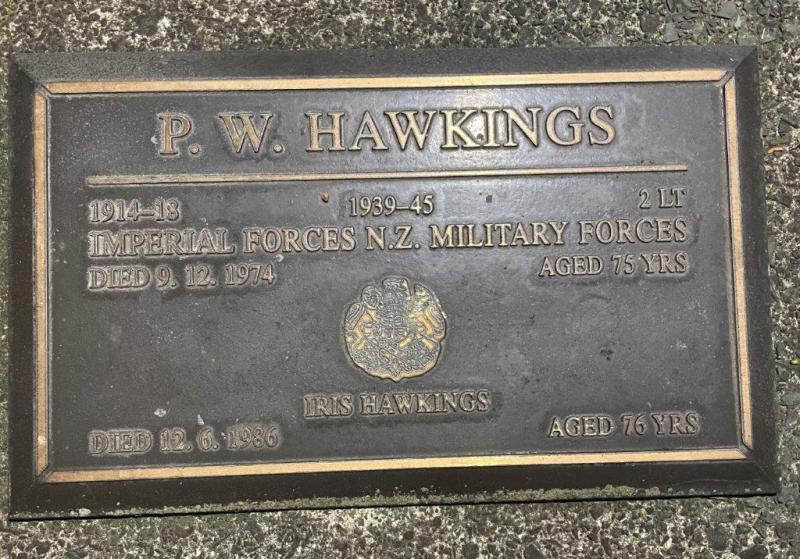Tim was born at Northam Farm. He went to New Zealand after the first world war and met Iris and they were married in 1927.
Tim was at home when his father died, and talked about the incident at the inquest. He then went to the war, joining the Worcester regiment. After the war he returned to Brean Down farm at some stage and was living there in the 1921 census working as the Farm Bailiff. There is also a credit from the RSPB

1922 – 27th Nov passenger on the Ruapehu to Wellington, New Zealand.
1925 returned to the UK on the Orsova in earl;y July and then returned to New Zealand via Sydney. Worked in the South Island.
1926 bought his farm in the Kaipara Hills.
1927 Married Iris.


From Life among the Hawkings (Denis Hawkings)
“We now have quite a change of scenery as we switch to New Zealand where Tim and Iris in the 1940’s were still living at Kaipara Flats on the North Island. There is surviving correspondence from him in April I 945 in which he describes that they are running two farms. The two eldest children, Joy and Donald, have left school and are helping them with this work which is mostly sheep farming although they have some steers. He tells that during the wartime he had been platoon commander in the local Home Guard and recently (I think 1944) he had been elected to the Rodney Council. In their leisure time the children play a lot of sports – Joy, Don and Fay all play hockey whilst Tim and Don are extremely keen on chess.”
SUNNY DOWNS
An article written for P.W. Hawkings
Mr Hawkings came to New Zealand from Somerset, where his family have farmed for centuries. Following service in World War 1 with the Imperial Forces, he left his homeland to gain experience, working on various sheep stations and as a shearer. He also operated threshing machines in Canterbury before moving north in 1926, later buying the Hills Farm, Matangeo, on the Kaipara Hills overlooking the Kaipara Harbour, where his son, after helping his father break in Sunny Downs, now lives.
Matangeo consists of two sections originally in heavy bush felled in the early 1900’s. It was badly neglected during World War 1, and, on taking over, Mr. Hawkings re-fenced and stocked heavily with sheep and cattle to crush the fern. Topdressing was done by hand right up until aerial topdressing was begun in 1953.
Here, Mr. D.J. Hawkings, son of Mr. P.W. Hawkings, has recently founded a beef Shorthorn herd with stock from L.E. Harris of Brooklands, Napier. The carrying capacity of this farm is now 1200 breeding ewes, 300 hogget and 150 cattle. The adjoining three sections were taken up in 1889 by Mr. E. Andrews (Mrs. P.W. Hawkings father), and were the first sections opened up on the Kaipara Hills.
In 1942, Mr. P.W. Hawkings took over his present farm of 190 acres of flat to rolling land six miles west of Warkworth, on the Kaipara Flats Road. It was part of a block owned by Mr. E. Hughes and in its original state was considered poor land, which grew only scrub and scattered bush. After the initial clearing it had reverted to gorse and second growth which Mr. Hawkings crushed with giant discs, cropping with Swedes before sowing down with good English grasses.
For the first 10years he limed heavily, using about six tons to the acre- a treatment which proved most successful. This heavy application has been reduced now the land is in good heart, and the topdressing is spread by wheel tractors. Numerous small plantations for shelter have been made, beginning with macrocarpa, and more recently Japanese cedars and Eucalyptus botryoides. About five acres of original bush containing kauri has been preserved at the back of Sunny Downs.
A rare and interesting form of native yellow pine, similar to kauri, called ‘Mangeao’ by the Maori, once grew in the swamps of Sunny Downs, but there is now only one of this rare species still living, although well-preserved logs are numerous in the swamp, and are reclaimed for use as fence posts and battens. It is thought that hundreds of years ago a severe frost may have killed all except this one tree which survived through being more sheltered than the others, and that conditions were unfavourable for regeneration by seed. The specimen still growing at Sunny Downs is the only one known in this district.
Another unusual feature of the property is that a bore, sunk in an unsuccessful search for oil, has since yielded an endless supply of pure water all through the year.
Sunny Downs carries about 900 breeding ewes, and 150 ewe hoggets through the winter, in addition to an Aberdeen Angus stud herd of 20 head which was begun in 1955 with foundation cows descended from Mangatoro and Matapihi cows in calf to Juan of Craigburn, and is still being built up. By crossing some of the Romney ewes with Southdown rams, lambs for the trade are bred and fattened.
Mrs. Hawkings takes a keen interest in farming-particularly in the Aberdeen Angus stud herd. Mr. and Mrs. Hawkings have three daughters, all married to farmers in the Rodney County, as well as a son, D.J. Hawkings., farming at Kaipara Hills. For four years, Mr. Hawkings served as a member of the Rodney County Council, but owing to ill health had to resign. He is an ardent outdoor bowler and is a foundation member of the Kaipara Flats Bowling Club.

Children
Joy born 1928
Don born 1929
Fay Born 1931
Gwen born 1932




You must be logged in to post a comment.